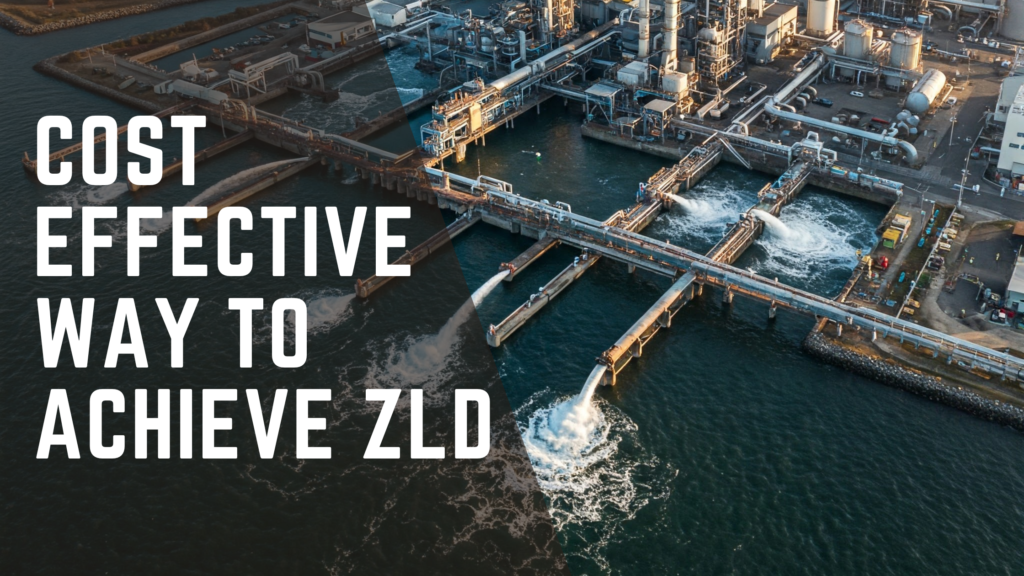Zero Liquid Discharge (ZLD) has become a necessity across industries facing rising environmental regulations and growing water scarcity. Across sectors, companies understand the importance of managing their water footprint. Environmental Norms & government regulations are tightening, water scarcity is intensifying, and sustainability has moved from a concept to a business necessity.
Yet, when it comes to implementing Zero Liquid Discharge (ZLD), cost remains the elephant in the room. Traditional systems, built around RO and MEE, demand massive capital investment and ongoing operational costs that can’t be justified. Therefore, industries need a sustainable, cost-effective, and different route to rethinking ZLD. Instead of viewing it as a complex, high-energy process, companies need solutions achievable with less machinery, lower energy consumption, and smarter design. This quieter revolution is beginning to reshape how industries approach water sustainability, both technically and economically.
Cost Effective ZLD Systems
Conventional ZLD systems come with layers of hidden costs that quickly add up. The conventional ZLD technologies like RO and multiple effect evaporators (MEE) are not only capital-intensive but also consume massive amounts of energy. Operating them means higher operating cost.
For companies having budget constraints, these cost factors can become a real challenge when planning for ZLD implementation. While the environmental benefits are clear, the financial and operational demands can make industries hesitant to act, even under regulatory pressure. In many cases, the fundamental rationale for ZLD implementation is not contested; rather, the decision centers on the practical and affordable means of achieving it.
A Smarter, Non-Conventional Approach to ZLD
Not all ZLD systems have to follow the same approach. At Scaleban, Contrary to the conventional reliance on energy-intensive processes, Scaleban advocates for a fundamentally different approach to ZLD, prioritizing inherent efficiency and minimizing complexity from the outset.
Instead of treating wastewater through energy-heavy stages like RO, Multi effect evaporator, or other conventional technologies, Scaleban allows industries to successfully utilize wastewater such as ETP treated water, RO reject, MEE feed & various other wastewater streams in the cooling towers in place of fresh water and operates at very high COC (15-20), with very high TDS up to 300,000 ppm i.e. 30% without affecting the plant performance by ensuring scaling, corrosion and biofouling free operations of condenser/ heat exchangers including entire cooling tower circuit. This will eliminate the use of costly conventional wastewater treatment technologies.
How Scaleban Saves Money
In the context of ZLD implementation, cost often serves as a critical decision parameter. The distinct advantage of the Scaleban solution lies in its inherent cost-effectiveness, achieved through simplicity, efficiency, and affordability from initial implementation.
Scaleban Saves Money for the industries in the following ways:
1. Lower Capital Investment
By eliminating the need for expensive technologies like RO and MEE, the upfront infrastructure cost is significantly reduced. Quick installation (3-4 days) zero footprints, and 80% less CAPEX & OPEX in comparison to conventional technologies.
2. Zero Energy Consumption
The Scaleban system is engineered & designed to function with zero energy demands. It operates by leveraging the existing flow within the system, ensuring optimal heat exchanger and cooling tower efficiency even at 30% TDS . This results in a significant reduction in operating costs associated with energy consumption.
3. Reduced Operating & Maintenance Expenses
Scaleban life is more than 20 years and doest require any annual maintenance; it significantly minimizes ongoing operational and maintenance expenditures. Unlike conventional technologies which require huge amounts of steam and energy, Scaleban’s innovative approach drastically reduces the need for routine interventions. In essence, the system is designed for longevity and reliable performance with no annual maintenance. This translates to lower labor costs, reduced downtime, and predictable long-term operational
4. Fast Return on Investment
Scaleban is a combination of 80% less Capital Expenditure (CapEx) and Operating Expenditure (OpEx) results in a significantly shorter payback period—often within 12 to 18 months. This timeframe represents a fraction of the time typically required for conventional systems to recoup their initial investment. In short, it’s not merely a cost-effective solution; it’s a more strategic and financially sound business decision.
5. Saving in water cost
By utilizing waste water in cooling towers, Scaleban eliminates the need of fresh water requirement in cooling towers resulting in fresh water cost saving and wastewater discharge cost savings as it will be utilized in cooling towers.
Lastly, the landscape of Zero Liquid Discharge is undergoing a significant transformation, and industries require affordable, cost-effective, and sustainable ZLD solutions. Therefore, SCALEBAN offers industries a viable pathway to achieve their environmental goals without the prohibitive costs often associated with conventional ZLD systems. This breakthrough not only addresses the pressing need for sustainable water management in the face of tightening regulations and increasing water scarcity but also presents a compelling economic advantage.
By significantly reducing operating costs through minimized energy consumption, lower maintenance, and the elimination of significant operational cost , Scaleban empowers industries to embrace ZLD not as a financial burden but as a strategic investment that benefits both industries and the environment. As industries continue to seek sustainable and economically sound solutions, Scaleban’s approach signals a promising future where Zero Liquid Discharge is no longer an expensive aspiration but an accessible and practical reality for a wider range of industrial operations.
